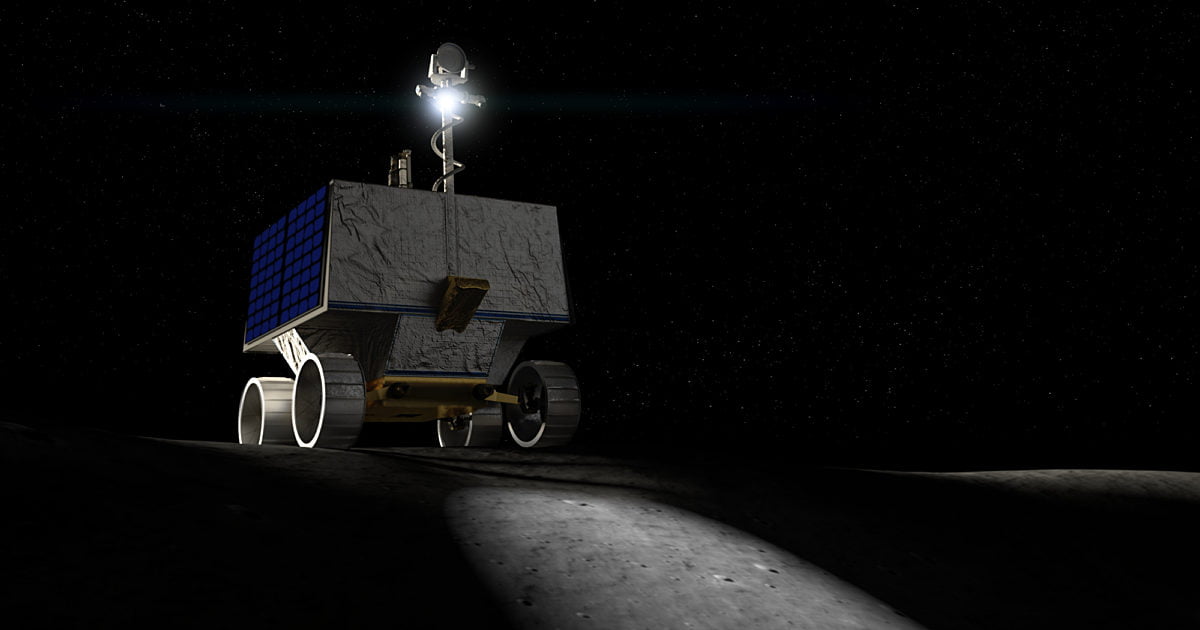VIPER, NASA’s Moon resource mapper
[ad_1]
How will VIPER map water on the Moon?
NASA has equipped VIPER with three spectrometers — instruments that can identify a material’s composition based on how they emit or absorb light — to collectively detect water ice on the surface and subsurface of permanently shadowed regions.
When exploring a region, VIPER will first use its neutron spectrometer to detect hydrogen — an indirect sign of water — up to 1 meter below the surface. VIPER will scout both inside and outside permanently shadowed regions for locations that show hints of substantial water ice. Once VIPER identifies a potentially water-rich area, typically in a permanently shadowed region, it will use its drill to dig up soil from up to a meter below the surface — the deepest for any robotic mission on another world.
Next, an infrared spectrometer will analyze the soil to determine if the detected hydrogen was part of water ice or hydroxyl (OH) bound to minerals. It will also identify other volatile resources like carbon dioxide, ammonia, and methane. Since volatiles evaporate even at moderately warm temperatures, some of them would escape the soil before the infrared spectrometer can detect them. This is where VIPER’s final instrument, a mass spectrometer, comes in. It will identify escaped volatiles from the soil that pass through it, as well as gases in the environment.
By repeating this entire process at various locations, VIPER will give us a holistic grasp on the exact nature, amount and accessibility of water in various conditions on the Moon’s poles.
Preparing VIPER for the abyss
On top of dealing with the numerous challenges in any Moon mission, NASA is designing VIPER to power through one of the harshest planetary environments in the solar system. With temperatures during major investigations well below -180 degrees Celsius (-292 degrees Fahrenheit), a rocky terrain riddled with steep slopes, a near-horizon Sun causing long, moving shadows that the rover needs to keep avoiding or face a freeze, we’re sending VIPER to lunar hell.
Despite facing much colder temperatures than NASA’s flagship Mars missions, VIPER doesn’t have a nuclear radioisotope for warmth. Instead, the solar-powered rover will rely on its battery and heat pipes to keep itself from freezing. VIPER can survive complete darkness for a little over four Earth days whereas a typical lunar night lasts 14 Earth days. VIPER will thus park at pre-identified high-altitude spots at various points during the mission where nights last only three to four Earth days.
To rove rocky polar terrain, go in and out of craters, and on soils likely different than elsewhere on the Moon, VIPER boasts unprecedented agility in a planetary rover. It can traverse 15-degree inclines with ease, and even 25 to 30-degree slopes if need be. VIPER can drive sideways, diagonally, or move in any direction without changing where it’s facing to keep its solar panels pointed at the Sun. If VIPER gets stuck in fluffy soil, it can lift each of its wheels independently to dig into and sweep along the surface — a bit like swimming — to get out of it. To prevent lunar dust from damaging its wheel system or internals, NASA is wrapping VIPER in multiple protective layers.
VIPER needs to stay connected to Earth during all of its scientific operations — a difficult task because it needs to enter craters to study water ice. To solve this, NASA used extensive mapping data from its Lunar Reconnaissance Orbiter to choose craters and regions with gentle enough slopes that maintain a line of sight to Earth while also meeting all other mission requirements.
[ad_2]
Original Post





I consider something genuinely special in this internet site.
Thank you, I’ve recently been looking for info about this topic for a long time and yours is the best I’ve came upon so far. However, what about the bottom line? Are you sure in regards to the source?
I was studying some of your posts on this internet site and I believe this web site is real informative ! Retain posting.
I like this web blog very much, Its a really nice berth to read and find information. “…when you have eliminated the impossible, whatever remains, however improbable, must be the truth.” by Conan Doyle.
I’ve been surfing on-line more than 3 hours lately, but I never found any attention-grabbing article like yours. It?¦s lovely worth enough for me. In my view, if all site owners and bloggers made just right content as you probably did, the internet shall be a lot more useful than ever before.
Puravive is a weight loss supplement that targets the root cause of weight gain issues in men and women.
What Is Sugar Defender? Sugar Defender Drops is a powerful friend for people who want to control their blood sugar levels
Hey there! I’m at work browsing your blog from my new iphone 4! Just wanted to say I love reading your blog and look forward to all your posts! Keep up the excellent work!